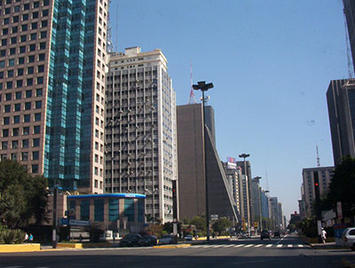
São Paulo is Brazil's largest urban area and ranks among the top 10 most populous in the world. Between 1950 and 1975, São Paulo was also among the globe’s fastest growing urban areas. For two decades starting in 1980 São Paulo ranked fourth in population among the world's urban areas, but has been displaced by much faster growing urban areas like Manila and Delhi.
São Paulo became Brazil's largest urban area, displacing Rio de Janeiro, in the middle 1960s. There has been no looking back. By 2025, the United Nations forecasts that São Paulo will have 10 million more people than Rio (Figure 1).
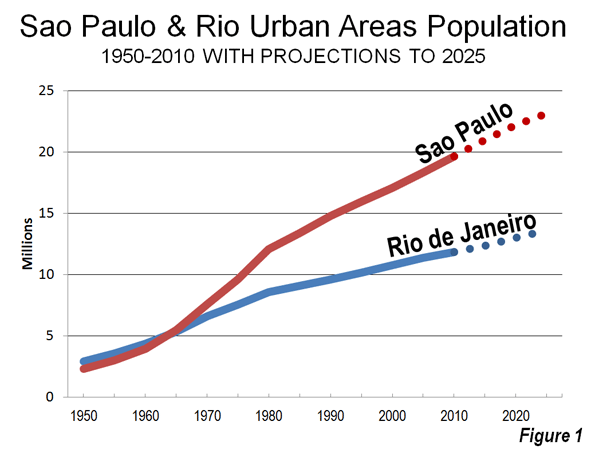
São Paulo is the capital of Brazil's largest state, also called São Paulo. The 2010 census counted more than 41 million people in the state, more than live in California. The state of São Paulo is substantially more densely populated than California, occupying only two thirds of the land area (approximately the size of Oregon).
There are other large urban areas in the vicinity of São Paulo. Campinas, an urban area of 2.5 million people, is located 60 miles (100 kilometers) north and San Jose dos Campos, an urban area of 600,000 is located 60 miles (100 kilometers) to the west.
A 20th Century City
Like many developing world megacities, São Paulo is a creation of the 20th century. In 1900, the population was 240,000. By 1950, the population had reached two million and now is approximately 20,200,000.
São Paulo is located on a small plateau, over the mountains from the Atlantic Ocean 2500 feet (750 meters) above sea level, approximately the same elevation as Madrid. São Paulo is the world's second largest urban area not located on an ocean or sea coast (Delhi is the largest).
São Paulo is located 50 miles (80 kilometers) from the seaport of Santos, which is an urban area of 1.7 million. Santos is reached by one of the world's most spectacular freeways, the Rodovia dos Imigrantes, which winds down the mountainside, with the southbound lanes crossing over the northbound lanes like the Interstate 5 Grapevine north of Los Angeles, the grade down from Puebla (Mexico) to the city of Orizaba on Autopista 150D and a section of the N205 approaching Chamonix-Mont-Blanc in France.
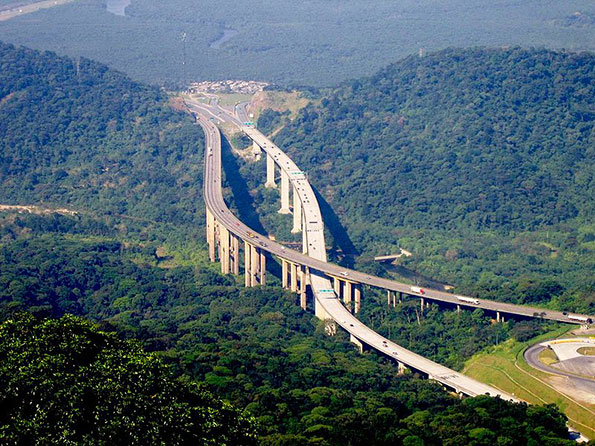
São Paulo’s Urban Expanse
São Paulo is a comparatively dense urban area, at 16,500 persons per square mile, or 6400 per square kilometer. This makes São Paulo somewhat less than double the density of Paris, but still one quarter the density of Hong Kong or Mumbai and one seventh the density of Dhaka. The urban area covers 1,225 square miles (3,175 square kilometers), similar in size to the Miami and Washington DC urban areas.
São Paulo is hardly a "compact city." The urban area stretches nearly 60 miles/100 kilometers east to west and more than 30 miles/50 kilometers north to south. The core city covers nearly as much area as the core city of Houston.
Recent Growth and Suburbanization
The central city (municipio) of São Paulo continues to grow. In the last 10 years, São Paulo has grown from 10.4 million to 11.2 million. A majority of the urban area population, 57 percent, continue to live in the central city. However there is much stronger growth in the suburbs, reflecting the trends in nearly all other major urban areas of the world. Since 1950, São Paulo's suburbs have experienced an explosive growth, rising from under 200,000 residents to 8.4 million. This exceeds the core city's growth over the same period of 7.46 million (Figure 2).
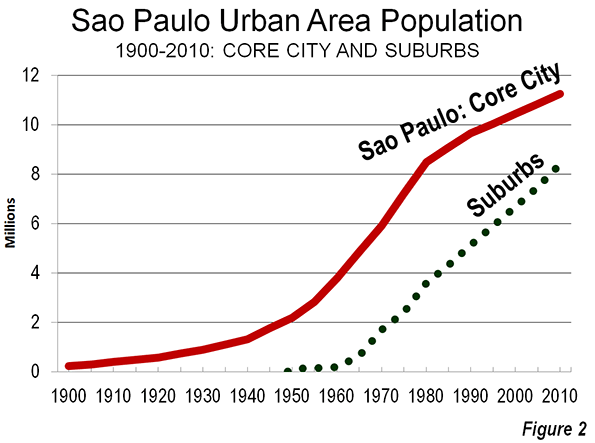
In the last 10 years, suburban São Paulo has grown from 6.7 million to 8.4 million people, capturing more than two thirds of the population growth. Since 1950, when the suburbs had approximately 5 percent of the population, they have increased their share in every census. However, if the strong growth of the city and the suburbs continues at the rates of the last 10 years, it could be 30 years before a majority of the population lives in the suburbs.
Deficient Transport
Like most nations, Brazil has a freeway or motorway system. There is a freeway between São Paulo and Rio de Janeiro and a freeway from São Paulo to the nation's third largest urban area, Belo Horizonte. These and other freeways emerge from the urban periphery, without traversing the core.
Yet, there is no way for trucks to traverse the São Paulo urban area from East to West without getting tied up in São Paulo’s monumental central area traffic. Nor is there a freeway for port traffic to cross the urban area south to north toward Campinas. Thus, truck traffic from the affluent urban areas of the South, such as Curitiba and Porto Alegre and the port at Santos is forced on to the Avenida Marginal Tiete and Avenida Marginal Pinheiros, forging an overused route adjacent to the urban core on both the west and north sides. East-west and north-south commercial traffic is combined on this roadway.
However, São Paulo is building a long overdue ring road, the Mario Covas Beltway. Less than one half of this route is now in operation and the whole circle will not be completed until 2015.
São Paulo is also on the trouble fraught high speed rail route proposed to run from Rio de Janeiro to Campinas. The route was roundly criticized by The Economist, which noted the low-balled costs, the astronomical ridership projections and the likelihood that Brazilian taxpayers would have to foot quite a bill to make it happen. This line was covered in more detail in Private Investors Shun Brazil High Speed Rail and High Speed Rail in Brazil: The Need for Guarantees.
From Monocentricity to Polycentricity
A number of other megacities in the developing world have added new commercial cores, becoming more polycentric, as the old central business district becomes comparatively less important. This is evident in Istanbul, Mexico City and Manila. In recent decades, most of the core-type commercial development has occurred along Avenida Paulista (two miles/three kilometers west of Centro) and then later, Luis Berrini (another 6 miles/10 kilometers further to the southwest).
The Shantytowns
As drivers travel on the Avenidas Marginal and the Mario Covas Beltway, they pass many shantytowns (favelas) close to the roadways. This can be a shocking site for North American rental car tourists. In more recent decades, favelas have developed not only on the urban fringe, but adjacent to affluent areas in the core (Photo). There are also corticos, which tend to be old subdivided houses and more centrally located. Both of these are increasingly interspersed through the urban area. A mid 1990s estimate placed the number of people living in this sub-standard housing at one quarter of the people in the central city of São Paulo.
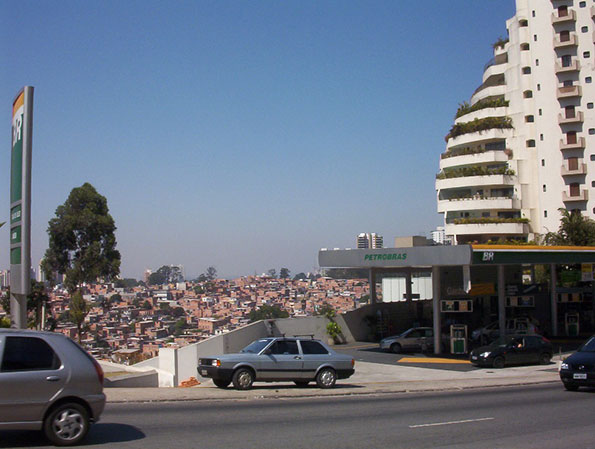 Favela and Affluence, core city of São Paulo
Favela and Affluence, core city of São Paulo
City of Hope
The origins of this movement to Sao Paulo are clear. People moved from the poor countryside, often from the sugar plantations of the Northeast. As bad as life may look to affluent northerners, things are much better here than back in the countryside. Otherwise they would go home, which occurs with no material frequency. São Paulo, like all big metropolitan areas, is a city of hope.
Wendell Cox is a Visiting Professor, Conservatoire National des Arts et Metiers, Paris and the author of “War on the Dream: How Anti-Sprawl Policy Threatens the Quality of Life.”
---
Lead Photo: Paulista Avenue (by author)













The On the internet, apart
The On the internet, apart from serving the purpose of information sharing and community developing, also brings great tidings for company houses, initiatives and enterprises. http://allcarsbrands.com/european-car-brands/
To help increase stamina and
To help increase stamina and energy, operate shuttle goes. It really is important to concentrate on gathering your strength, and you can do this with bodyweight picking up. click for more
Large weights and simple
Large weights and simple lifts should be used to achieve speed and power. click to read
I really like the topic you
I really like the topic you posted here. It was a great help for me. I gather many ideas and information through it. Im looking forward for your next post sooner. Thank you so much for exerting effort on posting this one. more learn
But generally you must
But generally you must target to have a €live€ incoming hyperlink to your web page that has a real value in online look for results placement. Going Here
By automating the invoicing
By automating the invoicing procedure and providing immediate accessibility records, companies can realize significant cost benefits and significantly enhance their cash control. http://www.avantissa.com/
The fact remains that SEO
The fact remains that SEO solutions assure customers that even if the website will not position among the top search search engines, the cash will not be a waste because of the return. Marvels Avengers Movie HD
I am extremely impressed
I am extremely impressed with your writing skills as smartly as with the structure to your weblog. Is that this a paid topic or did you customize it your self? Anyway stay up the excellent quality writing, it is uncommon to peer a great blog like this one today..
how to hack clash of clans
Thanks for a wonderful
Thanks for a wonderful share. Your article has proved your hard work and experience you have got in this field. Brilliant .i love it reading.
how to reverse neuropathy naturally
Excellent information on
Excellent information on your blog, thank you for taking the time to share with us. Amazing insight you have on this, it's nice to find a website that details so much information about different artists.
how does the girlfriend activation system work